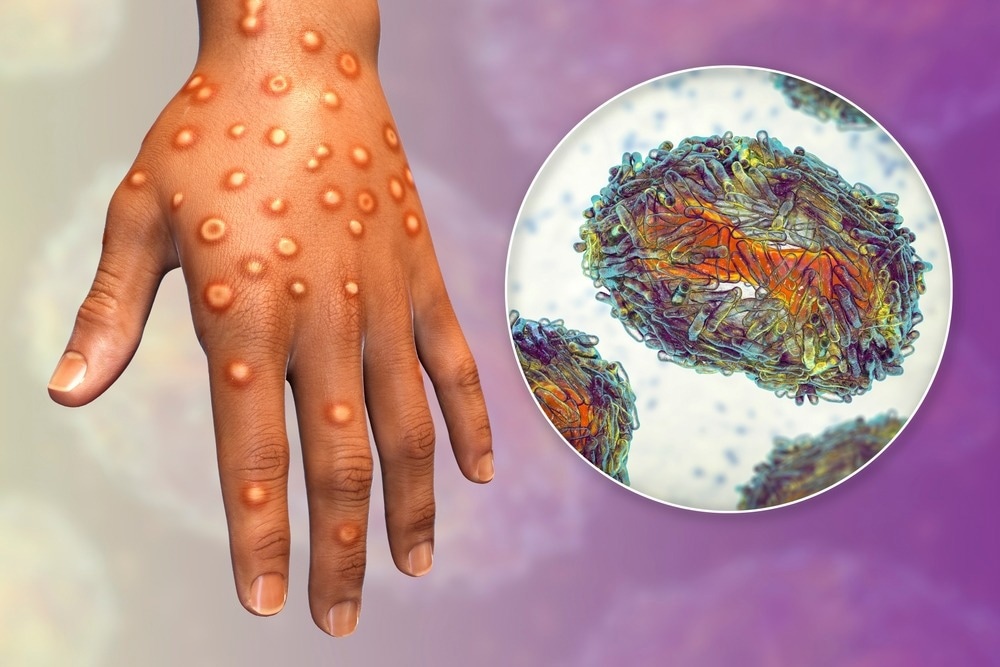The monkeypox outbreak has drawn the attention of scientists, as the virus can spread rapidly through close contact, respiratory droplets, and, perhaps, sexual fluids. In a recent JAAD Case Reports study, scientists present their dermatological approach to a suspected monkeypox case in New York City, along with associated histopathologic and clinical findings.

Study: It’s Here, Monkeypox: A Case Report. Image Credit: Kateryna Kon / Shutterstock.com
Background
The United States Centers for Disease Control and Prevention (CDC) state that monkeypox infection can be suspected when individual reports a rash of “deep-seated and well-circumscribed lesions, often with central umbilication; and lesion progression through specific sequential stages: macules, papules, vesicles, pustules, and scabs.”
Monkeypox can also be suspected when a patient meets one of four criteria within 21 days of symptom onset. These include men who have sex with men (MSM), history of travel to a country where monkeypox is endemic, contact with a person suspected of having monkeypox, and/or contact with dead or alive animals that are African endemic species.
Knowledge of the CDC criteria is crucial, as it could quickly alert dermatologists of a suspicious exanthem. This will help clinicians quickly prescribe self-isolation instructions to patients to limit the further spread of the virus.
The case report
The subject was a 31-year-old male who had recently returned from a vacation in Miami, Florida. He complained of fatigue and fever and, after several days, developed blisters on his body.
As the blisters were uncomfortable, he sought urgent care, which is when healthcare professionals sent the lesion swabs for reverse transcription polymerase chain reaction (RT-PCR) testing.
Importantly, no specific isolation instructions were given; therefore, the individual continued engaging in normal daily activities. Four days later, the patient presented at the authors’ dermatology practice, as the lesions had not resolved.
Dermatological examination
The patient was otherwise healthy and self-identified himself as gay; however, a detailed sexual history could not be obtained. When the patient presented at the dermatology practice, he was afebrile, and his vitals were stable.
About 20 two to eight millimeter (mm) umbilicated and pink papules were found across the entire body, all of which were at the same stage of development. The palms and soles also had five to six mm deep-seated pink vesicles with erosion.
Lesions were absent in the genitals and mouth. The patient also had bilateral inguinal lymphadenopathy.
Diagnosis
During the examination, proper protective care was taken, including the use of N95 masks and gloves. The possible diagnosis outcomes were herpes, simplex virus (HSV), varicella-zoster virus (VZV), syphilis, and monkeypox.
HSV and VZV were ruled out because, in these cases, the lesions are smaller and confined to a particular anatomical region. The painful nature, morphology, and distribution of the lesions made primary and secondary syphilis less likely.
The CDC criteria and recent travel history suggested “suspected monkeypox.” The patient was immediately forwarded to the NYC Health Department’s CDC Emergency Operations Center. Subsequently, the patient was advised a minimum of three weeks of quarantine to prevent the further spread of the virus.
Histological examination
Many multi-nucleated keratinocytes, as well as focal, full-thickness epidermal necrosis, were observed on histological examination. Consistent with a viral infection, lymphocytes, neutrophils, and red blood cells made up the dense dermal inflammatory infiltrate.
RT-PCR confirmed monkeypox DNA within the lesion samples. Within the next several weeks, skin lesions and fatigue self-resolved, and evidence of post-inflammatory hyperpigmentation was absent.
Conclusions
The monkeypox virus outbreak has placed a significant epidemiological burden on the MSM community. Appropriate public health strategies must be undertaken to protect the well-being of this community without perpetuating stigma. As demonstrated in this case report, dermatologists can have a crucial role in reducing the further spread of this virus.